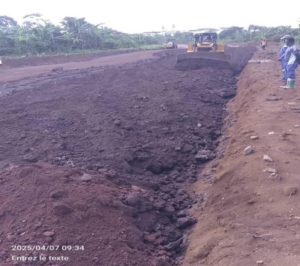Bangem, Cameroon – Construction activities along the 53-kilometre stretch connecting Bangem to Nguti in the Kupe-Muanenguba Division are advancing at a determined pace. This major infrastructure project, located in Cameroon’s Southwest region, is being executed under the supervision of the country’s elite military unit, the Rapid Intervention Battalion (BIR), working through direct labour.

This vital road, once completed, is expected to significantly enhance interconnectivity between Kupe-Muanenguba, Meme, and Manyu divisions, as well as improve trade routes toward the Littoral region and the Nigerian border. Its economic and strategic importance has mobilized multiple actors, including the local population whose cooperation has been instrumental despite ongoing security concerns in the area.
To support this effort, a special task force created by the Minister of Public Works is collaborating closely with BIR teams on the ground. This joint approach has ensured consistent progress, particularly during the project’s preparatory phase.
So far, major milestones have been achieved: survey and soil studies have been finalized for the first 10 kilometers, while laboratory analysis is underway on collected samples. The groundwork for the road is well underway, with foundational layers laid out over several kilometers. Notably, a large culvert structure near the start of the route has been completed, and a significant portion of the workers’ residential camp has also been constructed.
Drainage works have also moved forward, with a 2,000-meter masonry channel and additional runoff systems helping to manage stormwater flow across vulnerable sections. Furthermore, essential clearing and earth-moving operations now cover nearly 8 kilometers of the road alignment.
Despite this steady momentum, the project faces logistical and social hurdles. Issues such as delays in compensation for affected households and farmland, lack of an on-site testing laboratory, and transportation challenges for technical teams have posed setbacks. Concerns from residents about current drainage designs, as well as difficulties in relocating utility infrastructure, have also emerged as critical factors to address.
With the rainy season approaching, officials are seeking to deploy more personnel and equipment to keep the project on track. Improved access for monitoring teams and rapid resolution of community concerns remain top priorities to ensure that the timeline is met.
Auréole TCHOUMI
